For a Winterthur intern who graduated in 1991 before heading to Yale for a doctorate, the journey back to Henry Francis du Pont’s esteemed estate constituted an odyssey replete with globetrotting, research discoveries – and even some colorful dead birds.

Dennis Carr returned to Winterthur Museum, Garden & Library as the curator of “Made in the Americas: The New World Discovers Asia,” an exhibit which opened on March 26 after debuting at the Museum of Fine Arts, Boston (MFA).
During a recent presentation, Carr, now the Carolyn and Peter Lynch Curator of American Decorative Arts and Sculpture at the Boston museum, said that not only was it an honor for him to come full circle, but Winterthur offered the perfect venue to continue the first large-scale, Pan-American exhibition to examine the profound influence of Asia on the arts of the colonial Americas.
Visitors who regard globalism as a modern phenomenon – fueled by economics or the Internet – will quickly find that the exhibit upends that view. It provides compelling, visual evidence that despite the thousands of miles and many-month voyages centuries ago that separated the Americas from Asia, its influence proved pervasive and lasting.
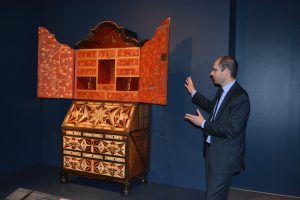
“We tend to think of globalism as a recent discovery, but globalism has its roots in the 16th century,” Carr explained. “The history of the colonial Americas has long been written as a series of encounters between Europe and the New World; however, the extraordinary objects in this exhibition encourage us to think more broadly about the Americas as being at the center of this global cultural and commercial exchange.”
About 80 works, including fine furniture, textiles, ceramics, silverwork, and paintings, which date from the 17th to the early 19th centuries, relay the complex story of how craftsmen throughout the hemisphere co-opted Asian styles in a range of objects. The exhibition features works from the MFA and Winterthur, and loans from public and private collections, many never previously seen publicly.
Carr said that beginning in 1573, Spanish ships set sail for Manila, laden with luxury goods from Asia, headed toward Acapulco, Mexico. The bounty for the English and French colonists in the Americas included silk and porcelain from China, painted screens and lacquer ware from Japan, and carved ivory from India and the Philippines.
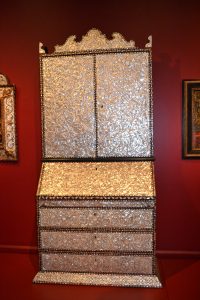
Amassing the items for the exhibit also required years of travel for Carr, who described one acquisition of a Mexican feather-work painting – an intricate technique utilizing bird feathers in such a way that they appeared to have been painted – posed a challenge. The Boston museum purchased the late 16th-century work entitled “St. Michael Slaying the Devil” and had to consult with ornithology experts to assure customs officials that no endangered birds were included in the work.
Carr said his travels also introduced him to items such as a painstakingly detailed Peruvian tapestry created as a balcony hanging in 1661 for the arrival of a viceroy, “objects that fell through cracks of art history.” The embroidery received its bright red color from cochineal, a natural dye derived from cactus-craving insects.
Linda Eaton, Winterthur’s John L. & Marjorie P. McGraw Director of Collections and Senior Curator of Textiles, served as the project curator for the Winterthur installation, and said the opportunity to juxtapose the artifacts was exciting, such as a rare 18th century shawl purchased by Henry Francis du Pont and some early embroidery that is double-sided.
“The range of exquisite objects ‘Made in the Americas’ brings together is remarkable, but it is the riveting scholarship presented that is eye-opening,” she said. The exhibit should help explain why decorative art historians grimace when globalism is touted as a recent addition to the mainstream.
“This is not new,” she said. “We clearly lived in a global age long before the internet and smartphone.”
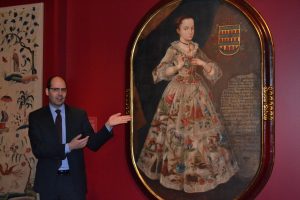
“Made in the Americas: The New World Discovers Asia” is an exhibit that requires viewers to take their time and read the detailed descriptions about the work. Those who do will be rewarded with insight as well as education. The approximately 80 pieces in the exhibit range from examples of “chinoiserie,” which translates as “in the Chinese taste” and created a global sensation during the colonial period, to Peruvian furniture inlaid with mother-of-pearl and tortoiseshell.
Among the rarest pieces of furniture in the exhibition is a desk-and-bookcase from mid-18th-century Mexico. It boasts a dramatic interior displaying chinoiserie-style painting in gold on a red background. Reminiscent of early colonial maps drawn by indigenous artists, the inside of the doors reveals an extensive hacienda in Veracruz.
The items on display include treasures from Mexico City, Lima, Quito, Quebec City, Boston, New York, and Philadelphia dating from the 17th to the early 19th centuries. Carr said only about 10 pieces differ from the Boston show. He said some of the textiles were too fragile to move from New England; however, they were quickly replaced with items from Winterthur’s collection.
He said the opening of the exhibition in Boston in 2015 was timed to mark the 450th anniversary of the Galleon trade between the Philippines and Mexico, inaugurated in 1565 and lasting for two and a half centuries, until 1815. He said that the exhibit proved popular and that he hopes audiences in the Philadelphia region will share that enthusiasm.
At Winterthur, the exhibition will be accompanied by a range of special programming, including concerts, dancers, cuisine, and wine tastings. For more information, visit winterthur.org/madeintheamericas.
Carr said the exhibition has served as a catalyst for reevaluation of traditional history, art history, and other curricula relative to the period. He said that professors at Harvard taught a course in the fall that was inspired by the exhibit, and other institutions, such as the University of Delaware, have also expressed interest in adding this new scholarship into their curriculums.
Backed by DuPont, Glenmede and John L. and Marjorie P. McGraw with additional support from M&T Bank and Potter Anderson & Corroon LLP, the exhibit will continue through Jan. 8, in the Winterthur Galleries.


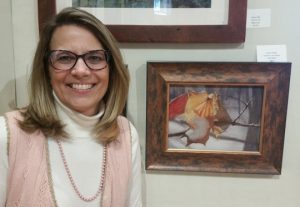
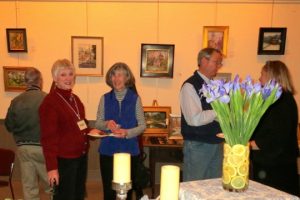
Comments